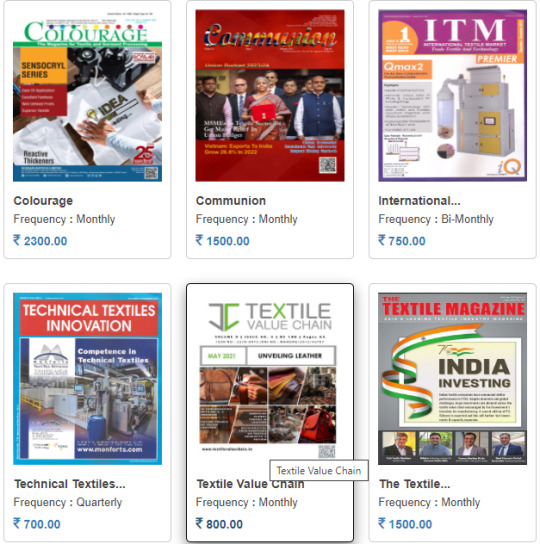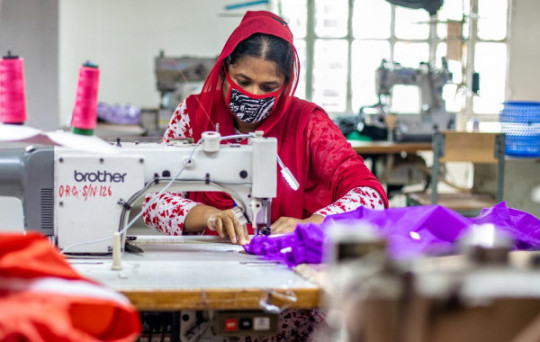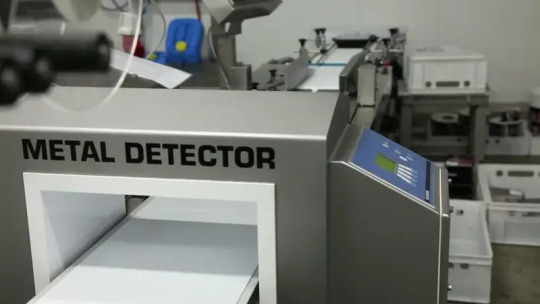#garmentindustry
Text
Cutting-Edge Innovations in Woven Interlining
Woven interlining, a crucial component in garment manufacturing, has seen remarkable advancements in recent years. These innovations are transforming the textile industry by enhancing performance, durability, and sustainability. As technology advances, so does the innovation in woven interlining. Here’s a look at some of the most notable trends and innovations currently shaping the textile industry:
Smart Fabrics: One of the most exciting developments is the integration of smart fabrics with woven interlining. These fabrics can respond to environmental changes, such as temperature or humidity, providing enhanced comfort and functionality.
Eco-Friendly Materials: Sustainability is a major focus in today’s textile industry. Innovations in interlining fabric now include eco-friendly materials, such as recycled fibers and organic cotton, which help reduce the environmental impact of textile production.
Advanced Bonding Techniques: New bonding technologies are improving the adhesion between woven interlining and outer fabrics. Techniques like ultrasonic bonding and heat-sealing are creating more durable and flexible options, including non woven fusible interlining and woven fusible interlining.
Customization and Personalization: Modern technology allows for greater customization of woven interlining. You can now find interlining in garments solutions that are tailored to specific fabric types, garment designs, and performance requirements.
Enhanced Breathability and Flexibility: Innovations are also focusing on improving the breathability and flexibility of woven interlining. New materials and weaving techniques are designed to enhance airflow and movement, making garments more comfortable to wear.
Cutting-edge innovations in woven interlining are driving significant changes in the textile industry. From advanced materials and technologies to eco-friendly practices and customization, these developments are enhancing garment quality and meeting the evolving demands of modern fashion.
This guide will equip you with the knowledge to take your garment construction skills to the next level and create clothes that look and feel truly professional.
#WovenInterlining#TextileInnovation#FabricTechnology#CuttingEdgeTextiles#GarmentIndustry#InterliningRevolution
0 notes
Text
The Bangladesh garment industry faces significant challenges as it struggles to keep up with production demands due to a shortage of cotton. The recent floods across the country have compounded an existing backlog of delayed orders caused by ongoing political unrest and protests. This situation presents a complex challenge for one of the world's leading clothing manufacturing hubs.
Bangladesh ranks as the third-largest exporter of clothing globally, following China and the European Union. In 2023 alone, the country exported apparel worth $38.4 billion. However, recent disruptions highlight vulnerabilities in the supply chain. According to industry officials, the unprecedented flooding has obstructed transportation routes, particularly affecting the movement of cotton from Chittagong port to factories. As a result, garment production has reportedly dropped by 50%. Mohammad Hatem, president of the Bangladesh Knitwear Manufacturers and Exporters Association, noted, “The industry is now under immense pressure to meet deadlines, and without a swift resolution, the supply chain could deteriorate even further.”
Impact of Flooding and Political Turmoil
The floods have rendered transportation infrastructure nearly unusable. Limited access to cotton supplies affects not only the quantity but also the timeliness of production. Rubana Huq, a prominent factory owner in Dhaka, described the financial impact of lost production. Her factory typically produces 50,000 shirts daily; at a selling price of $5 per shirt, the recent disruptions represent a potential loss of $250,000.
In addition to natural disasters, political instability is further complicating matters. Earlier this month, protests led to factory closures, causing additional delays in garment production. As production resumes, Huq estimates that a full recovery could take at least six months. This slowdown could result in a business loss of up to 15% as buyers shift their orders to countries with more stable supply chains, such as India and Vietnam.
Shifting Supply Chains
Commodity analysts forecast a diversion of cotton shipments to neighboring countries. As international clients reassess their sourcing strategies, Bangladesh may inevitably lose market share. “We are already hearing and seeing some cotton for prompt delivery wanted by Pakistan and Vietnam,” noted Louis Barbera, a partner and analyst at VLM Commodities. Additionally, companies in southern India are positioning themselves to accommodate new orders that would typically go to Bangladesh.
The situation raises significant concerns for garment workers and manufacturers alike, many of whom depend on the sector for their livelihoods. Bangladesh's ready-made garment industry, which comprises more than 80% of the country's total export earnings, plays a crucial role in the economy. As the industry grapples with these interconnected issues, the need for swift resolution is paramount to avoid permanent damage to its reputation and market position.
The Broader Implications
The challenges facing the Bangladeshi garment industry serve as a cautionary tale for other emerging markets heavily reliant on a single export sector. Disruptions can arise from unexpected events, whether they be natural disasters or political instability. The need for a diversified supply chain and better contingency planning is more evident than ever.
Additionally, buyers globally are adopting a more cautious approach amid these uncertainties. Shahidullah Azim, director of the BGMEA industry group, stated that the protracted state of unpredictability hampers their ability to maintain production momentum. Without clear communication and resolution of these pressing issues, long-standing relationships between suppliers and international buyers may come under strain.
Conclusion
The ongoing turmoil within the garment industry highlights the interconnected nature of global supply chains. The current crisis in Bangladesh underscores the necessity for
strategic planning and risk management in a sector that is sensitive to both environmental and political shocks. As the country seeks to stabilize its operations, the lessons learned may influence how other countries approach their own manufacturing strategies moving forward.
0 notes
Text

Quality assurance is essential for any apparel business. To ensure that your garments meet the highest standards, here are the 5 easy steps to establish an effective garment inspection process. Check out our guide now for more information on the latest developments in garment inspection.
Learn more at https://tinyurl.com/msmj5xrr
#garmentinspection#garment#garmentindustry#garmentquality#quality#measurement#button#apparel#apparelnews#news#fashionnews#fashion
0 notes
Text

𝐁𝐮𝐲 𝐍𝐨𝐰 𝐓𝐞𝐱𝐭𝐢𝐥𝐞 𝐚𝐧𝐝 𝐆𝐚𝐫𝐦𝐞𝐧𝐭 𝐏𝐫𝐨𝐜𝐞𝐬𝐬𝐢𝐧𝐠 𝐈𝐧𝐝𝐮𝐬𝐭𝐫𝐲 𝐌𝐚𝐠𝐚𝐳𝐢𝐧𝐞𝐬
Textile and garment processing magazines provide valuable insights and information about the textile industry, including fabric production, garment manufacturing, textile processing techniques, industry trends, and innovations. Subscribing to these magazines helps professionals, enthusiasts, and individuals interested in the textile and garment processing field stay updated with the latest developments and advancements.
#TextileTechMag#GarmentProcessing#FashionInnovation#TextileInsights#SustainableFashion#FabricTechnology#GarmentIndustry#TextileMagazine#FashionEngineering#StitchingSolutions#magazine#magaizesubscriptions#subscribe
0 notes
Text

#Oxyblum#garmentsmanufacturing#Specialize#schooluniform#bag#HosptialCloth#garment#garments#garmentdistrict#garmentconstruction#garmentprinting#garmentfactory#garmentsewing#garmentmanufacturer#garmentbali#garmentdyed#garmentindustry#garmentory#garmentcare#garmentbag#garmentaccessories#garmentdesign
1 note
·
View note
Text
ERP for Textile Manufacturing & Garment Industry
As DataNote is an OpenLogic Framework, here the customization become configuration which takes lesser time and gives the fast result. The workflow in textile and garment/apparel industries can be controlled and managed using DataNote. Order status in DataNote keeps changing in tandem with specific processes completed to manufacture the finished product; this feature helps to understand the order status and WIP.
0 notes
Text
15 Ways to Improve Productivity in Garment Production
15 Ways to Improve Productivity in Garment Production
#productivity #garmentproduction #garmentindustry
15 Ways to Improve Productivity in Garment Production
Swati Wadekar
Executive IE officer at PratibhaSyntex, Indore
Email: [email protected]
Introduction:
The world is changing very fast and becoming more and more challenging. Every minute counts, especially in the production sector where time equals money. Productivity is a common focus in production organizations, and authorities stress its…

View On WordPress
4 notes
·
View notes
Text
SUBSIDIES FOR GARMENT INDUSTRIES:
Direct Credit assist you to take a subsidies (ODOP) upto 25Lacs for growing your business as per below table:
#subsidies#garmentindustry#industry#directcredit#odop#growing#business#directcredit#PoweringAspirations#LoanAgainstProperty#Homeloan#Personalloan#Businessloan#personalloan#privatefinance#loanapproval#loan#creditcard#personalloan#loanservices#loanoptions#successkey#finance#insurance
0 notes
Video
youtube
Clothing Industry _ Designer Howe's Introduction
-------------------------
Designers Makers Creators Engineers with Technic Skillful Talent will Make the Brands the Best and That is why We introduce these Design Collection in the First New Year 2023′s New Design Collection of All Textiles in Clothing Industry go together with Jewelry like this High Light Navy Leather Hand Bag in Fashion Industry Here with you ,
Thank you for Watching and See you in the Next Time !
From American Family of American Chefs & American Artists & American Song Writer and Musician & American Designer Howe’s Design Introduction !
#design #designs #shortsdesign #shortdesign #designer #designing #manufacturing #manufacturer #manufacturers #manufactory #designermaker #fashiondesigner #fashionmaker #clothing #clothingbrand #clothingindustry #fashionindustry #garment #garments #garmentindustry #clothingfactory #fashionwear #creator #maker #readytowear #textiles #textile #textileindustry #valuechain #textilerecycling #apparel #appareldesign #apparelmanufacturing #apparelmanufacturer #apparelfactory #appareldesigner #apparels #fashiontechnology #clothingfashion #skillful #hightech #hightechnology #clothingproduction #fashionproducts #fashionproduction #fashionfactory #designermaster #printingpress #embroidery #clothingmanufacturer #clothingmaker #clothingmanufacturing #clothingmanufacturers #industries #texas #usa
1 note
·
View note
Photo

Project Complete in Noida. Thanks for cooperate #merabaghicha team And Sajjan Aparels pvt. Ltd. #noida #exporthouse #sajjanaparels #manrug #greaternoida #garmentindustry CoOperate Coffice (at Noida नोएडा) https://www.instagram.com/p/Buts7ILga4s/?utm_source=ig_tumblr_share&igshid=1buavh9rf09dr
1 note
·
View note
Photo

Consumed: On Colonialism, Climate Change, Consumerism, and the Need for Collective Change by Aja Barber ⭐️⭐️⭐️⭐️⭐️ If you recognize the need for massive change in the way we consume and the way the fashion industry contributes to climate change, this is the book - or audiobook- for you. @ajabarber’s friendly voice is a balm to the despair you will inevitably feel while learning about how fast fashion exploits the global south and our consumerist impulses while destroying the planet and funneling money into the pockets of the wealthiest. But that’s just the “learning” half of the book. The “unlearning” half is full of advice on how to shift your desire to acquire and decouple your worth from what you wear. She gives you practical advice on seeing past greenwashing, and encourages you to only wear clothing you feel good in when shopping so everything in the store doesn’t make you feel the urge to purchase your way to a new, better self. She gives tips on how to engage as an activist, including a template letter to send to your local reps or corporate boards. The UK’s Environmental Audit Committee’s 2019 report Fixing Fashion: Clothing, Consumption & Sustainability gives some recommendations we can use: -Greater supply chain transparency - Strengthening the Modern Slavery Act - Funding for an end of life cycle for clothes - a charge of 1 penny per garment on producers could fund this, and result in better clothing collections and sorting - would result in new green jobs - Retailers must take responsibility for the social and environmental cost of clothes. Find some of these suggestions and contact your local reps about them. Personally, I find @goodonyou_app and @sustainableoutfits are great resources for evaluating brands by ethical and environmental standards. #consumerism #fastfashion #ethicalfashion #environmentalist #fashionindustry #garmentindustry #garmentworkers #fastfashionsucks #sustainability #sustainablefashion #sustainableliving #books #bookreview #bookstagram #bookrecommendations #readthis #goodreads #readingchallenge #environmentaljustice #workersrights #pollution #climatechange #climateaction #climatecrisis https://www.instagram.com/p/CiDNog7Oidm/?igshid=NGJjMDIxMWI=
#consumerism#fastfashion#ethicalfashion#environmentalist#fashionindustry#garmentindustry#garmentworkers#fastfashionsucks#sustainability#sustainablefashion#sustainableliving#books#bookreview#bookstagram#bookrecommendations#readthis#goodreads#readingchallenge#environmentaljustice#workersrights#pollution#climatechange#climateaction#climatecrisis
0 notes
Text
Understanding Non-Woven Interlining
Non-woven interlining plays a crucial role in enhancing the quality of garments in the fashion industry. Unlike woven interlining, which is created by weaving threads together, non-woven interlining is produced by bonding fibers using methods such as heat, pressure, or adhesives. This bonding process results in a fabric that is both versatile and highly functional, making it an essential component in modern garment construction.
Non-woven interlining is particularly valued for the support and structure it provides to garments. Its unique properties make it an ideal choice for a variety of applications, from reinforcing collars and cuffs to maintaining the shape of waistbands and hems. Whether you’re working with fusible interlining, which adheres to the fabric when heated, or exploring other types, differences and benefits of each is key to achieving the best results in your fashion projects.
Non-woven interlining is characterized by its softness, flexibility, and breathability; it is made by bonding fibers mechanically or chemically, rather than weaving or knitting them. This gives it a unique texture and performance qualities that are well-suited for a wide range of garments. Additionally, non-woven interlining comes in various weights, textures, and finishes, offering designers and manufacturers the flexibility to choose the perfect type for their specific needs.
This guide will equip you with the knowledge to take your garment construction skills to the next level and create clothes that look and feel truly professional.
#NonWovenInterlining#InterliningFabric#GarmentIndustry#FashionTech#TextileManufacturing#FusibleInterlining
0 notes
Photo

@amazing.clicker @anurag.purti ☎ - 9709181919 #garmentdyed #garmentshoot #garmentfactory #garmentdecoration #garmentindustry #garmentdistrict #garmentconstruction #intags #garmentory #garmentbag #garmentworkers #garmentmaking #garmentdistrictnyc #garmentreproductionofworkers #garmentmanufacturer #garmentsewing #garmentproject #garmentcare #garmentdesign #garmentproduction #garmentaccessories #garmentbandung #garmentbali #garmentdye #garment #garmentindonesia #garmentprinting #garmentmanufacturing #garments #garmentsurabaya (at Ranchi, Jharkhand) https://www.instagram.com/p/CbaCPkwh48c/?utm_medium=tumblr
#garmentdyed#garmentshoot#garmentfactory#garmentdecoration#garmentindustry#garmentdistrict#garmentconstruction#intags#garmentory#garmentbag#garmentworkers#garmentmaking#garmentdistrictnyc#garmentreproductionofworkers#garmentmanufacturer#garmentsewing#garmentproject#garmentcare#garmentdesign#garmentproduction#garmentaccessories#garmentbandung#garmentbali#garmentdye#garment#garmentindonesia#garmentprinting#garmentmanufacturing#garments#garmentsurabaya
0 notes
Text

📣 Did you know that a metal detection machine is an important part of apparel manufacturing? This equipment helps to detect and remove any metallic objects such as buttons, zippers, hooks, snaps, rivets, and other components. Visit us for more info about metal detection machines and how they can help your apparel production process! 🤖
Read more at https://tinyurl.com/mr42wapz
#apparel#garment#garmentindustry#metaldetection#metaldetectionmachinebrands#metaldetectionmachine#metaldetectionguide#measurement#needledetection#needledetectionmachine
0 notes
Photo

LIFE … “100 Photographs That Changed The World” 2003. Triangle Shirtwaist Company Fire [1911]. The #triangleshirtwaistcompany always kept its doors locked to ensure the young immigrant women stayed stooped over their machines and didn’t steal anything. When a fire broke out on Saturday, March 25, 1911, on the eighth floor of the New York City factory, the locks sealed the workers’ fate. In just 30 minutes, 146 were killed. Witnesses thought the owners were tossing their best fabric out the windows to save it, then realized workers were jumping, sometimes after sharing a kiss (the scene can be viewed now as an eerie precursor to the World Trade Center events of September 11, 2011, only a mile and a half south). The Triangle disaster spurred a national crusade for workplace safety. Photo by the International Ladies’ Garment Workers’ Union. #ushistory #garmentindustry #laborlaw #osha #factorylife https://www.instagram.com/p/CZc8bp_rn-w/?utm_medium=tumblr
0 notes
Photo

#OnThisDay August 7, 1887 this silk banner from our extensive union banner collection was presented to the New York Journeymen Tailors Protective and Benevolent Union! Organized in 1862, they are one of the earliest unions that still exists from the American garment industry. The two-sided, 66x55″ piece was hand stitched (as it says on the cream colored side) by the ladies of the union. The eagle and American shield testify to the patriotism of the members and the laurel in the eagle’s beak and at the base of the shield is an icon representing victory and glory. The red fabric at the top of the cream colored side is a sleeve made to ensure the fragile banner can be displayed. This banner is one of the oldest textiles in our collection from the Kheel Center’s UNITE HERE NY Joint Board Banner collection and were historically used during a parade, rally, or to commemorate union anniversaries! #6200mb #KheelCenter #ILR #CornellRAD #archiveslife #laborarchives #laborhistory #labor #unions #labormovement #archivesofinstagram #fromthearchives #history #laborhistory #JourneymenTailors #textilehistory #unionbanners #garmentworkers #garmentindustry https://www.instagram.com/p/CSRiyhEriJH/?utm_medium=tumblr
#onthisday#6200mb#kheelcenter#ilr#cornellrad#archiveslife#laborarchives#laborhistory#labor#unions#labormovement#archivesofinstagram#fromthearchives#history#journeymentailors#textilehistory#unionbanners#garmentworkers#garmentindustry
1 note
·
View note